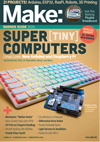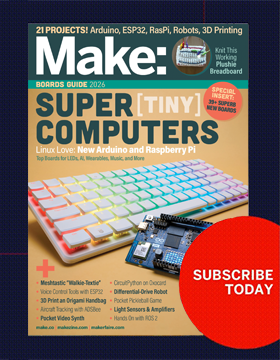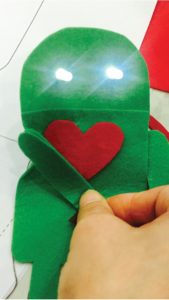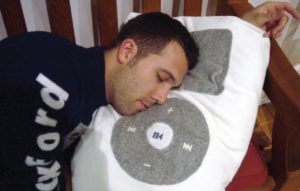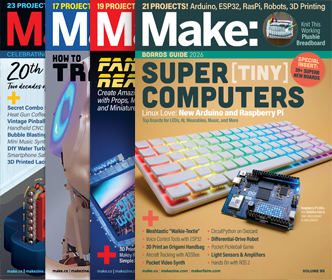
A Silly Ghost
WHAT WILL YOU MAKE?
A felt ghost with eyes that light up with LED lights!
WHAT WILL YOU LEARN?
You will learn to sew a circuit and switch.
STEPS
STEP 2
Cut out the outline of your character.
STEP 3
If you're making the ghost I'm demonstrating, use your scissors to cut a slit where you want the mouth located and insert the tongue so that it sticks out the front.
STEP 4
Glue the tongue to the back of the character so that it can still flap up and down in the front.
STEP 5
Using fabric glue, glue your battery holder on the back of your character. Make sure that the positive and negative sides of the holder are facing the right way.
STEP 6
Now, using an awl, poke four holes in the felt for the legs of your LEDs.
STEP 8
Place the legs of the LEDs into the holes, making sure that the long legs are in the positive holes and the short legs are in the negative holes.
STEP 9
After curling the legs of the LEDs on the back side of the character, connect the two positive legs of the LEDs with conductive thread.
STEP 10
Next, connect the conductive thread from the two positive legs to the positive side of the battery holder.
STEP 11
Connect the two negative legs of the LEDs with conductive thread.
STEP 12
Link this connection with one side of your switch. In my example, I sewed under the mouth of the ghost.
Sew back and forth a few times underneath the ghost's mouth. You want to make sure that there is enough conductive thread exposed for your switch to make a reliable connection.
STEP 13
Connect the negative side of the battery holder to the other side of your switch. In my example, I sewed it to the bottom of the ghost's tongue.
STEP 14
Again, make sure to sew back and forth a few times or in a circle so that there is enough conductive thread exposed for your switch to work well. See close-up of the two sides of the switch.
WHAT'S HAPPENING HERE?
A circuit is a loop made up of different components that allows electricity to flow. In a series circuit, the electrical current is only able to flow around a single path. The current will flow from a power source, such as a battery, into one or more electrical loads, such as a light bulb, and then back to the power source. The Voltage in a series circuit is divided up across all of the loads. In a parallel circuit, the electrical current may flow along multiple paths before returning to the power source. The voltage in a parallel circuit is the same across all of the loads in the circuit.
WHAT'S NEXT?
By using a parallel circuit and using a switch creatively, as you did in the ghost project, you can make a wide range of characters and create some fun interactions. For instance, you can try making up a story about your character so when you touch different parts of its body, lights turn on as shown in the Whoops! Robot.
This project can even be taken to the next level by making a fully functional “Super iPod” pillow!
Materials:
- felt
- LEDs
See More Projects in these topics:
Arts & Crafts Electronics Fiber ArtsSee More Projects from these themes:
Art/Craft Studio Carnival/Theme Park The Shop (Makerspace)Maker Camp
Please Note
Your safety is your own responsibility, including proper use of equipment and safety gear, and determining whether you have adequate skill and experience. Power tools, electricity, and other resources used for these projects are dangerous, unless used properly and with adequate precautions, including safety gear and adult supervision. Some illustrative photos do not depict safety precautions or equipment, in order to show the project steps more clearly. Use of the instructions and suggestions found in Maker Camp is at your own risk. Make Community, LLC, disclaims all responsibility for any resulting damage, injury, or expense.
Maker Camp Project Standards
Based on NGSS (Next Generation Science Standards)
National Core Arts Standards
The National Core Arts Standards are a process that guides educators in providing a unified quality arts education for students in Pre-K through high school. These standards provide goals for Dance, Media Arts, Music, Theatre, and Visual Arts with cross-cutting anchors in Creating, Performing, Responding, and Connecting through art. The Anchor Standards include:- Generate and conceptualize artistic ideas and work.
- Organize and develop artistic ideas and work.
- Refine and complete artistic work.
- Select, analyze, and interpret artistic work for presentation.
- Develop and refine artistic techniques and work for presentation.
- Convey meaning through the presentation of artistic work.
- Perceive and analyze artistic work.
- Interpret intent and meaning in artistic work.
- Apply criteria to evaluate artistic work.
- Synthesize and relate knowledge and personal experiences to make art.
- Relate artistic ideas and works with societal, cultural, and historical context to deepen understanding.
NGSS (Next Generation Science Standards)
The Next Generation Science Standards (NGSS) are K–12 science content standards. Learn more.Forces and Motion
- 3-PS2-3. Ask questions to determine cause and effect relationships of electric or magnetic interactions between two objects not in contact with each other.
- HS-PS4-5. Communicate technical information about how some technological devices use the principles of wave behavior and wave interactions with matter to transmit and capture information and energy.
National Core Arts Standards
The National Core Arts Standards are a process that guides educators in providing a unified quality arts education for students in Pre-K through high school. Also see Standards with cross-cutting anchors in Creating, Performing, Responding, and Connecting through art for Visual Arts.NGSS K-2 Engineering Design
The Next Generation Science Standards (NGSS) are K–12 science content standards.- K-2-ETS1-1. Ask questions, make observations, and gather information about a situation people want to change to define a simple problem that can be solved through the development of a new or improved object or tool.
- K-2-ETS1-2. Develop a simple sketch, drawing, or physical model to illustrate how the shape of an object helps it function as needed to solve a given problem.
- K-2-ETS1-3. Analyze data from tests of two objects designed to solve the same problem to compare the strengths and weaknesses of how each performs.
NGSS 3-5.Engineering Design
The Next Generation Science Standards (NGSS) are K–12 science content standards.- 3-5-ETS1-1. Define a simple design problem reflecting a need or a want that includes specified criteria for success and constraints on materials, time, or cost.
- 3-5-ETS1-2. Generate and compare multiple possible solutions to a problem based on how well each is likely to meet the criteria and constraints of the problem.
- 3-5-ETS1-3. Plan and carry out fair tests in which variables are controlled and failure points are considered to identify aspects of a model or prototype that can be improved.
NGSS MS.Engineering Design
The Next Generation Science Standards (NGSS) are K–12 science content standards.- MS-ETS1-1. Define the criteria and constraints of a design problem with sufficient precision to ensure a successful solution, taking into account relevant scientific principles and potential impacts on people and the natural environment that may limit possible solutions.
- MS-ETS1-2. Evaluate competing design solutions using a systematic process to determine how well they meet the criteria and constraints of the problem.
- MS-ETS1-3. Analyze data from tests to determine similarities and differences among several design solutions to identify the best characteristics of each that can be combined into a new solution to better meet the criteria for success.
- MS-ETS1-4. Develop a model to generate data for iterative testing and modification of a proposed object, tool, or process such that an optimal design can be achieved.
ALL DONE? SHARE IT!
Share pictures and videos of your cool build! Be sure to use #maketogether or #makercamp
POST YOUR PROJECTS